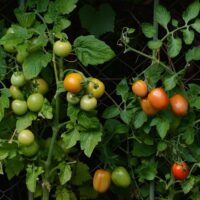Tomatoes and Acidity
This week I was asked, “My young son gets some red irritation around his mouth when he eats lots of tomatoes. Why does this happen?”
The answer: acid in the tomato is irritating the area where it comes in contact. Citrus fruits may have the same effect. 
There are some varieties such as Roma (plum), Oxheart Pink, Oxheart Yellow and Yellow Pear which are considered to be low in acid.
Golden Boy or Lemon Boy and Golden Jubilee are examples of low-acid tomatoes that turn yellow as they ripen.
Yellow tomatoes are typically less acidic than traditional ones. Their nutritional value differs slightly from that of red tomatoes. They have more niacin and folate, but less lycopene and vitamin C.
Tomatoes that fall into the low-acid range tend to have smaller amounts of seed, and more flesh than other varieties.
Good to know if you have a problem digesting tomatoes due to their acidity—or if you have a little one who loves tomatoes and gets a red ring around the mouth.
You can reduce the acidity of tomatoes by adding a pinch of baking soda after you cook them. Be careful to add only a pinch so that you don’t ruin your sauce. You can also remove the seeds.
The longer tomatoes are cooked, the more acidic they become. This is because the tomatoes lose more water and fiber if boiled longer. In the same way as reducing the cooking time can lower the acid content, avoiding cooking tomatoes will also reduce their acidity. 
Tomatoes help with heart and skin health and cancer prevention.
If you have a patio or area that gets lots of sun, you can try growing your own tomatoes. Here in the Region, it’s usually safe to plant on Mother’s Day weekend.
Wishing you a beautiful week.
Much love,
Health Coach Carol
“It’s difficult to think anything but pleasant thoughts while eating a homegrown tomato.”—Lewis Grizzard


